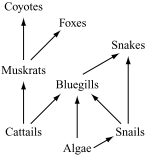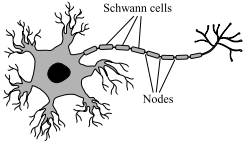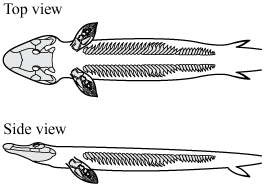Protein pumps actively transport ions across a cell’s plasma membrane. What molecule directly supplies the energy required for this transport?
A. ATP
B. cholesterol
C. oxygen
D. tRNA
A partial food web is shown below.

Which organisms in the food web are both primary and secondary consumers?
A. bluegills
B. cattails
C. coyotes
D. snakes
Some populations of Atlantic tomcod fish have an allele that makes the fish resistant to toxic pollutants called PCBs. Tomcod populations in several rivers were analyzed for the presence of this allele. Each river had varying levels of PCB pollution.
Which of the following results would best support the conclusion that natural selection is influencing the presence of this allele in the tomcod populations?
A. All of the tomcod in each of the rivers have this allele.
B. The percentage of tomcod with this allele remains the same from year to year in each river.
C. The rivers with high PCB levels have larger percentages of tomcod with this allele than the rivers without PCBs.
D. Eggs from tomcod without this allele can hatch in rivers with or without PCBs, and eggs from tomcod with this allele can only hatch in rivers without PCBs.
For a new liver cell to form, DNA replication is necessary because it ensures that the newly formed cell has which of the following?
A. two copies of the original cell’s DNA
B. an identical copy of the original cell’s DNA
C. a rearranged copy of the original cell’s DNA
D. only the best parts of the original cell’s DNA
The axons of some vertebrate neurons are wrapped with special cells called Schwann cells, as shown below.

Which type of signal jumps from node to node between the Schwann cells to move down the axon?
A. a digital pulse
B. a magnetic pulse
C. an electrical signal
D. a glycoprotein signal
Which of the following is a characteristic that distinguishes viruses from B. thetaiotaomicron and S. epidermidis?
A. Viruses lack mitochondria.
B. Viruses lack genetic material.
C. Viruses are unable to accumulate mutations.
D. Viruses are unable to reproduce outside of host cells.
Which of the following statements best explains why introduced species often threaten native species in an ecosystem?
A. Introduced species often have less genetic diversity than native species.
B. Introduced species often lack natural predators in their new environment.
C. Introduced species often form mutualistic relationships with native species.
D. Introduced species often cause short-term droughts in their new environment.
uniper is a desert plant that produces toxins. Unlike most animals, a type of rodent called Stephen’s woodrat is able to eat juniper plants. The woodrat has special liver enzymes to metabolize juniper toxins.Which of the following statements best explains why the special liver enzymes became common in the woodrats?
A. The enzymes allow the woodrats to grow much larger.
B. The enzymes make the woodrats poisonous to their predators.
C. The enzymes reduce the genetic diversity and variety of traits of the woodrats.
D. The enzymes increase the ability of the woodrats to survive and pass on their genes.
A scientist is studying the inheritance of two genes, gene R and gene P, in dogs. Each gene is located on a different chromosome. Gene R has two alleles, R and r, and gene P has two alleles, P and p.
What are the expected probabilities for the genotypes of gametes produced by a dog with the genotype RrPp?
A. 50% Rr and 50% Pp
B. 50% RP and 50% rp
C. 50% Rp, 25% rP, and 25% rp
D. 25% RP, 25% Rp, 25% rP, and 25% rp
When astronauts are in low-gravity environments, their bodies begin to release stored calcium. As a result, which of the following most likely occurs when an astronaut returns to Earth?
A. The risk of inflamed tendons increases.
B. The chance of breaking a bone increases.
C. The stomach’s level of functioning decreases.
D. The blood’s ability to carry oxygen decreases.
Which of the following best explains how antibiotic resistance spreads through some populations of S. epidermidis?
A. All S. epidermidis cells exposed to antibiotics respond by developing mutations.
B. Some S. epidermidis cells exposed to antibiotics survive and pass their genes on to their offspring.
C. Exposure to antibiotics causes S. epidermidis cells to learn simple behaviors that help the cells survive.
D. Exposure to antibiotics causes an increase in the respiration rate of S. epidermidis cells living on the skin.
Researchers have observed that the biodiversity of some mountainside rain forests is greater than the biodiversity of some lowland rain forests. Which of the following statements best explains why a high degree of biodiversity is observed in some mountainside rain forests?
A. Some mountainside rain forests have high emigration rates.
B. Some mountainside rain forests have species with high reproductive rates.
C. Some mountainside rain forests have many different environmental niches at different elevations.
D. Some mountainside rain forests have increased numbers of producer species and reduced numbers of predator species.
A researcher observed army ants, which form colonies with one queen ant and many worker ants. The researcher observed worker ants moving from place to place to hunt and collect a variety of food for the colony. The queen ant was observed mating with a male ant from another ant colony. The queen produced many eggs after this mating.
Which of the following could help increase the genetic diversity in the colony of army ants?
A. the queen ant mating with the ant from a different colony
B. the worker ants collecting the food for the colony to eat
C. the worker ants moving from place to place
D. the queen ant eating a variety of food
Cattle normally have two separate toes on each foot. In a condition called mulefoot, a recessive allele causes the toes to fuse, resembling the foot of a mule.Two cattle, each with normal, separate toes, have a calf with mulefoot. What is the probability that the next calf born to these parent cattle will also have mulefoot?
A. 0%
B. 25%
C. 75%
D. 100%
Each part of the human digestive system has a specific function. Which of the following activities best models the role of the esophagus?
A. shaking a small piece of chalk in a plastic bottle
B. cutting a clay cube into smaller and smaller cubes
C. squeezing a small greased ball through plastic tubing
D. placing a small piece of egg in dilute hydrochloric acid
Which of the following describes one way B. thetaiotaomicron helps in digestion?
A. It breaks down lipids into fatty acids.
B. It breaks down proteins into amino acids.
C. It breaks down polysaccharides into simpler sugars.
D. It breaks down nucleic acids into nitrogenous bases.
Prolonged periods of drought in an area cause decreases in plant population sizes. Which of the following statements describes how the decreases in plant population sizes then affect other populations in the area?
A. Omnivore population sizes increase, and herbivore population sizes increase.
B. Omnivore population sizes decrease, and carnivore population sizes increase.
C. Herbivore population sizes increase, and carnivore population sizes decrease.
D. Herbivore population sizes decrease, and carnivore population sizes decrease.
Scientists discovered a 375-million-year-old fossil in Canada. The diagram below shows the top and side views of the fossil.

Which observation would best support the hypothesis that this organism was a transitional form between amphibians and fish?
A. The fossil has a long body, which both modern amphibians and modern fish have.
B. The fossil is larger than most modern amphibians, but smaller than most ancient fish.
C. The fossil has some body structures that are similar to amphibians and some body structures that are similar to fish.
D. The fossil was discovered near a lake, which shows that the organism needed water to reproduce, as do amphibians and fish.
In humans, an X-linked recessive allele (Xb) causes red-green colorblindness. Which of the following crosses could produce a female who is red-green colorblind?
A. XBXB×XbY
B. XbXb×XBY
C. XBXb×XbY
D. XBXb×XBY
Four boys have the same biological mother and father. What percentage of each boy’s chromosomes come from the mother?
A. 0%
B. 25%
C. 50%
D. 100%
Several parts of an animal cell are involved in the processes of protein synthesis, packaging, and export. Which of the following correctly places the cell parts in the order in which they are involved?
A. nucleus → vacuole → cell membrane
B. mitochondria → vacuole → cell membrane
C. ribosome → endoplasmic reticulum → Golgi complex → cell membrane
D. lysosome → endoplasmic reticulum → Golgi complex → cell membrane
The oceans have become increasingly acidic in recent years as the water absorbs more and more carbon dioxide from the atmosphere. This increased acidity interferes with the ability of corals to maintain their skeletons. In addition, an increase in water temperatures worldwide is causing coral bleaching, another condition that threatens the health of coral reefs. Based on this information, which of the following would most improve the health of coral reefs?
A. reducing the use of fossil fuels
B. eliminating nuclear power plants
C. removing more natural gas embedded in rocks
D. replacing offshore oil drills with onshore oil drills
Two populations of fish live in separate water drainage systems in southeast Arizona. The populations are geographically isolated from one another, but the fish appear similar. Which of the following questions would be most useful to ask to help determine whether these two populations are the same species?
A. Are the food sources the same for the two populations?
B. Do the two populations’ habitats have the same water pH?
C. Do young fish in the two populations mature slowly or quickly?
D. Can individuals from the two populations successfully interbreed?
All six codons listed below code for the same amino acid during protein synthesis.
CGU, CGC, CGA, CGG, AGA, AGG
Which of the following statements describes an advantage of having multiple codons for the same amino acid?
A. The length of the protein chain will be reduced.
B. The effect of mutations in the DNA could be reduced.
C. The ribosome will more quickly read the order of the bases during translation.
D. The cell could use the bases that are most available in the nucleus to assemble DNA.
Dentists often use medicines called local anesthetics when removing a tooth so that the patient does not feel pain. Which of the following statements describes how local anesthetics block pain?
A. The anesthetic molecules attach to the lining of the mouth and constrict blood vessels there.
B. The anesthetic molecules bind to sensory neurons and prevent them from sending nerve impulses to the brain.
C. The anesthetic molecules bind to motor neurons and prevent them from sending nerve impulses to the mouth.
D. The anesthetic molecules enter the salivary glands and cause large amounts of saliva to be released in the mouth.